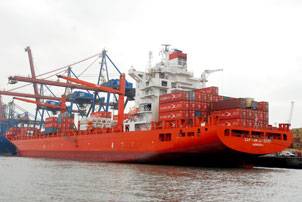Hamburg Süd Supports Low-Sulphur Fuel Tests
For the second time this year, the United States Environmental Protection Agency (EPA), with the support of Hamburg Süd, has been able to generate important data on possible contaminant reductions in marine shipping.
In late August 2010, Low Sulphur Marine Gas Oil (LSMGO), a fuel with a sulphur content of 0.1%, was used on the container ship Cap San Lorenzo – deployed in the service between U.S. Gulf and Caribbean/South America East Coast –while the vessel was entering and departing the port of Santos. According to the EPA, it was the first test of this kind to take place in Santos.
The use of LSMGO had previously been tested on the Cap San Lorenzo in April 2010 in the ports of Veracruz, Altamira and Houston, in the Gulf of Mexico.
"We recognize and applaud the efforts of fleet owners, such as Hamburg Süd, who voluntarily engage in emissions reduction strategies like fuel switching,“ said Gina McCarthy, U.S. EPA’s Assistant Administrator for Air and Radiation. “EPA estimates that a ship can achieve a 95% reduction in sulphur dioxides and an 85% reduction in fine particulates when lower sulphur fuels are used. “
A number of areas with tighter sulphur limits, known as Emission Control Areas (ECAs), have now been bindingly defined. Since January 2010, for example, the fuels used at berths within the European Union have been allowed to contain no more than 0.1% sulphur. As of August 2012, only fuel with a sulphur content of 1% will be permitted on the North American Atlantic and Pacific Coast, as well as the U.S. Gulf Coast.
“We are glad that this fuel switching project will yield emissions data to show U.S., Mexican and Brazilian policy makers that real reductions can be achieved by burning lower-sulphur fuels near their coastlines," observed Michelle DePass, U.S. EPA’s Assistant Administrator for International and Tribal Affairs, underlining the significance of the tests. Along with Hamburg Süd, these tests were also supported by the U.S. Maritime Administration, the Mexican environmental agency Secretaría de Medio Ambiente y Recursos Naturales (SERMANAT), as well as the ports of Houston, Veracruz, Altamira and Progreso.












